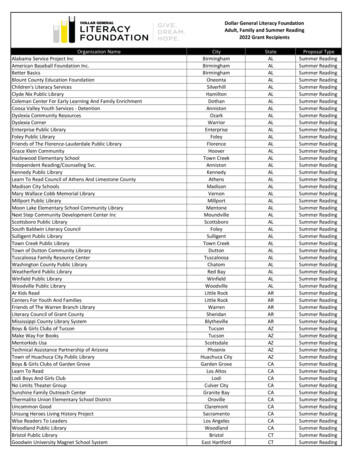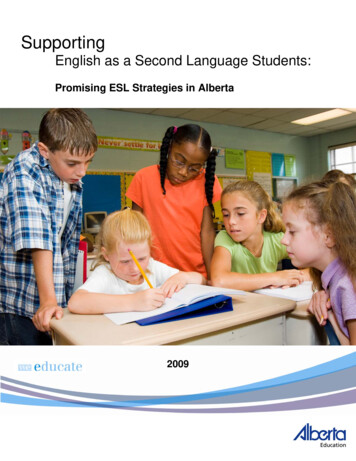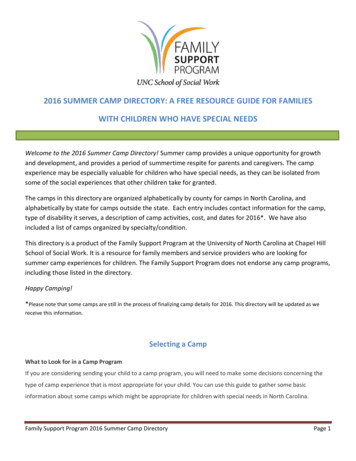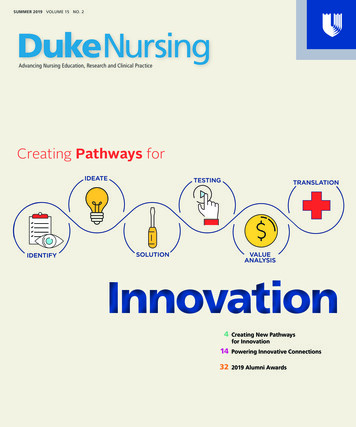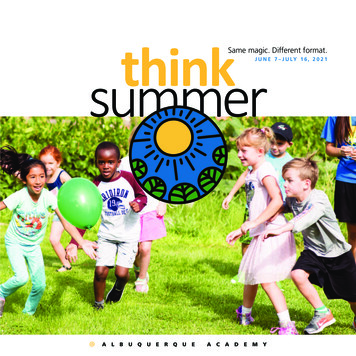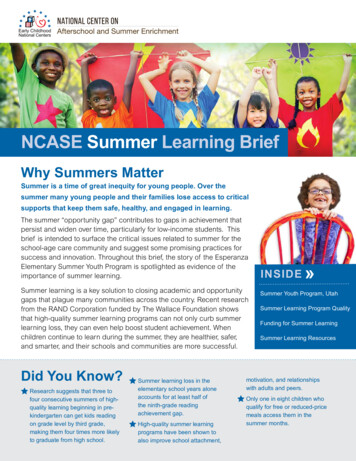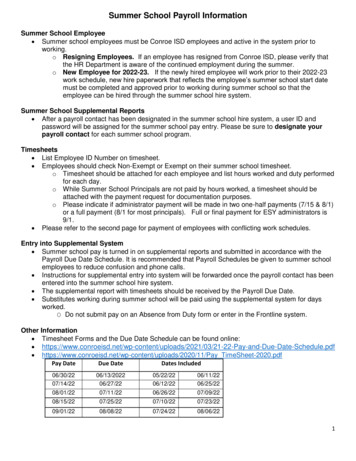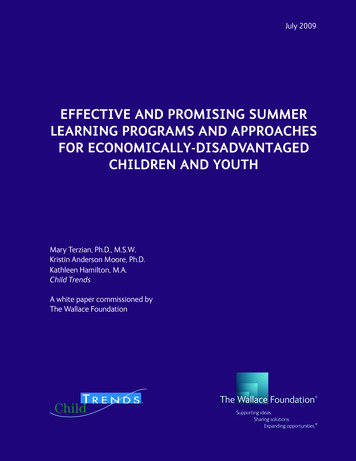
Transcription
July 2009EFFECTIVE AND PROMISING SUMMERLEARNING PROGRAMS AND APPROACHESFOR ECONOMICALLY-DISADVANTAGEDCHILDREN AND YOUTHMary Terzian, Ph.D., M.S.W.Kristin Anderson Moore, Ph.D.Kathleen Hamilton, M.A.Child TrendsA white paper commissioned byThe Wallace Foundation
Effective and Promising Summer Learning Programs andApproaches for Economically-Disadvantaged Children and Youth:A White Paper for the Wallace Foundation1Mary Terzian, Ph.D., M.S.W.Kristin Anderson Moore, Ph.D.Kathleen Hamilton, M.A.July 10, 20091This updated White Paper corrects several errors in the initial version. Specifically, for the BELL program, mathimpacts are not significant and, for STEP, impacts are not significant for high school completion and mixed forcollege enrollment. These corrections have been marked with an asterisk (*) in Table 2 – pages 14 to 16 (revisedJanuary 2010).
Executive SummaryChildren and youth who reside in economically disadvantaged households and who live in lowresource, urban neighborhoods are more likely to lose ground in reading over the summer thantheir middle- and upper-income peers. These children and youth also often come from ethnicminority backgrounds. In addition, both lower and higher income students lose ground in mathover the summer. The academic disparities between low-income and higher-income childrenincrease as children grow older, widening this achievement gap. Summer learning programs arean important strategy for “narrowing the gap”.In 2007, then-Senator Barack Obama (D-IL) and Senator Barbara Mikulski (D-MD) reintroduced the Summer Term Education Programs for Upward Performance Act (STEP UP) act,which supports increasing summer learning opportunities for disadvantaged students, toCongress. More recently, Obama/Biden’s position paper entitled “Plan for Lifetime Successthrough Education”1 recommends “expand[ing] summer learning opportunities” as a way tonarrow the achievement gap. In light of these recent calls for action, identifying effective andpromising summer learning approaches for this population is imperative.This White Paper summarizes findings from an extensive literature review that was conducted toidentify effective and promising models and approaches for meeting the needs of low-incomechildren, youth, and families during the summer months. Special attention is paid to summerlearning programs that serve urban, low-income children and youth. Data on programparticipation suggest that children and youth who would stand to benefit the most from summerlearning programs (i.e., children and youth who are economically disadvantaged, have lowschool engagement, and/or exhibit problem behavior) are the least likely to participate.Experimental and non-experimental studies, as well as reports and practitioner insights, werereviewed to identify effective and promising summer learning practices. Program impacts fromexperimental evaluations were identified for outcomes ranging from reading achievement to anincreased likelihood of employment. Drawing from a limited number of experimentalevaluations, we found that reading achievement gains were achieved for a handful of programs,whereas math achievement was less often evaluated. Few impacts were found on high schoolcompletion, college enrollment, and employment. Finally, a lack of evidence was found foryouth development and health and fitness outcomes due to the fact that these outcomes wererarely, if ever, evaluated.Without question, there is a lack of experimental research to measure the impacts of summerlearning programs on children and youth. At the same time, we have some preliminary evidenceto suggest that good summer learning programs can improve the educational and careerdevelopment outcomes of economically disadvantaged students. Strategies for preventingsummer learning loss include: (a) identifying effective summer learning programs andapproaches and replicating them; (b) extending effective school-year, out-of-school timeprograms that have academic components through the summer; (c) improving existing programsby incorporating characteristics of effective and promising programs; and (d) establishingextended-year or year-round schools that incorporate practices and approaches from effectivesummer learning programs.2
Table of ContentsHistory and Background . 5Data on Summer Program Participation. 6Findings from the 1999 National Survey of America’s Families . 6Sociodemographic Differences . 7Social-Behavioral Differences in School and Out-of-School Time Involvement . 7Other Social-Behavioral Differences. 9What are Summer Learning Programs? . 10How do Summer Learning Programs Differ from Summer School? . 10How do Summer Learning Programs Differ from School-Year, Out-of-School TimePrograms? . 11What Outcomes do Summer Learning Programs Target? . 12Experimental Evaluations of Summer Learning Programs . 12Methods Used to Identify Experimental Evaluation Studies . 13Findings of Experimentally-Evaluated Programs . 13Characteristics of Effective Programs (Based on Experimental Studies). 16Non-experimental Evaluations of Summer Learning Programs . 18Methods Used to Identify Non-Experimental Evaluation Studies. 18Findings of Programs with Non-Experimental Evaluations . 18Characteristics of Promising Summer Learning Programs. 20Characteristics of Effective and Promising Programs Based on All Evaluations, ResearchStudies, and Reviews . 20What Do Experimental and Non-Experimental Studies of Summer Learning Programs TellUs? . 21What Do Experimental Studies of School-Year, Out-of-School Time Programs Tell Us AboutImproving Youth Development Outcomes? . 22What Do Experimental Studies of School-Year, Out-of-School Time Programs Tell Us AboutImproving Health and Fitness Outcomes? . 23Knowledge gaps . 24Discussion . 253
Recommendations for Practice . 25Approach A: Identify Effective Summer Learning Programs . 25Approach B: Extend Effective School-Year Programs . 26Approach C: Improve Existing Summer Learning Programs. 27Approach D: Establishing Extended-Year or Year-Round Schools . 28Recommendations for Research and Evaluation . 28Bibliography of Summer Learning and Out-of School Time Resources . 30Appendix A . 34Table 3: Summary of Evaluated Programs (N 43) . 34Appendix B . 35Table 4: Effective Experimentally-Evaluated Programs with At Least One Positive Impact . 35Table 4 continued: Experimentally-Evaluated Programs with At Least One Positive Impact . 36Table 5: Experimentally-Evaluated Programs with Mixed or Null Findings . 37Table 5 continued: Experimentally-Evaluated Programs with Mixed or Null Findings . 38Appendix C . 394
History and BackgroundSummer learning and enrichment programs (including educational camps and summer readingprograms) originated in the late 1880s (Fiore, 2005), if not before. By this time, perceptions ofyouth residing in urban, inner-city areas had shifted from viewing children as little adults whoneeded religious education and distance from the social problems of urban life to viewing themas individuals who needed guidance and support from caring adults and social institutions. Whilesome programs focused on developing vocational and reading skills, others, like Trailblazers,focused on the development of values and life skills. Trailblazers was founded in 1887 toimprove the youth development outcomes of poor children from New York City. Thisorganization, which runs a summer camp on a 1,100 acre Nature Conservancy area in NewJersey, continues to this day. Organizations like Trailblazers paved the way for summer campsand many other youth serving organizations.Although summer camp programs in the U.S. have a rich history, few have undergone rigorousevaluation and even fewer are designed to support the needs of economically disadvantagedyouth. This is partially because many parents with limited resources can not afford to send theirchildren due to the cost of tuition. Overnight or sleep away camps range from 2 to 8 weeks andcost 300 to 2000 per week; day camps cost substantially less, but are rarely offered free ofcharge.2 Nonetheless, summer camps are believed to promote child and adolescent well-being. Arecent pre-experimental (no comparison group, no random assignment), study of 3,395 familieswhose child attended one of 90 day or residential summer camps for at least one week foundimprovements from pre-test to post-test in positive identity, social skills, physical and thinkingskills, and positive values and spirituality.3In recent years, attention to summer learning programs for disadvantaged children and youth hasgrown. Much of this heightened attention may relate to the impetus of the No Child Left Behindlegislation and by studies on summer learning loss which find that low-income youth regressmore in reading skills over the summer than their higher income peers. 4,5,6 For example,Alexander and his colleagues (2007)7 found that about two-thirds of the ninth-grade academicachievement gap between economically disadvantaged and advantaged teens can be explained bysummer learning loss during the elementary school years. The reasons low-income studentssuffer greater reading loss than higher-income students are not fully understood. Some haveattributed this phenomenon to less time spent reading, less access to books at home, and less timespent in the library during the summer months than their middle- and high income peers.8 Othershave speculated low-income students are more highly affected because they do not have as manyresources and opportunities in their homes and neighborhoods to cushion the lack of schoolstructure, learning, and support.Offering disadvantaged youth access to a variety of summer learning experiences has become apriority for the new administration. In their position paper entitled “Plan for Lifetime Successthrough Education”, 9 President Barack Obama and Vice-President Joe Biden recommend“expand[ing] summer learning opportunities” as a way to narrow the achievement gap. ThisWhite Paper may be viewed as a resource to inform funders, policymakers, and administrators onthe various ways in which they may respond to this recent call for action.5
Data on Summer Program ParticipationOut of 11 nationally-representative surveys reviewed, only four surveys – the National Survey ofAmerica’s Families (NSAF) 199910, the Early Childhood Longitudinal Study – KindergartenCohort (ECLS-K)- 1998-9911, the Child Development Supplement (CDS) to the Panel Study ofIncome Dynamics (PSID) 200212, and the Current Population Survey (CPS)13 1996, – offeredinformation on summer program participation.14 Findings for three of these surveys aresummarized below: An analysis of ECLS-K 1998-99 data found that approximately 1 out of 5 childrenparticipate in overnight or day camps. Children with a high socioeconomic statusbackground were about 8 times more likely to participate than children with a lowsocioeconomic status background (42.5 percent versus 5.4 percent). 15An analysis of CDS-PSID 2002 data found that children and adolescents (aged 6 to 17)from higher income families were more likely to participate in summer overnight campsand more likely to participate in organized activities during the summer. In addition,white children and adolescents were more likely to participate than non-white childrenand adolescents, with Hispanic children and adolescents being the least likely toparticipate. 16An analysis of the CPS 1996 data found that 36 percent of children aged 6 to 11participate in organized summer activities.17The following analysis builds on existing work by examining NSAF data to explore additionalcorrelates of summer program participation, such as social-behavioral factors and school andout-of-school-time involvement. In addition, the NSAF 1999 variable specifically asks aboutsummer programs. The question is worded: ““Is [your child] attending a summer program?”(Section C: Parent/Child/Family Interaction and Education, item C02). [Although 2002 data areavailable, these data do not include variables that focus exclusively on summer programparticipation.]Findings from the 1999 National Survey of America’s FamiliesWe analyzed the summer version of the 1999 NSAF survey (of 6,656 households), to explorewhether children aged 6 to 11 who participate in summer programs differ from children who donot participate. Analyses of overall participation suggest that 1 in 4 children participate insummer programs.18 This proportion falls in between the proportions obtained in analyses of theECLS-K 1998-99 and the CPS 1996. It is higher than the ECLS-K finding (20 percent), mostlikely because the ECLS-K item is limited to overnight and day camps; and it is lower than theCPS 1996 finding (36 percent), most likely because the CPS 1996 item uses more inclusivewording (“organized summer activities, such as camp, organized recreation or sports, specialinterest programs, or [lessons/classes]”).Overall, summer program participation rates are lower than participation rates for school-year,out-of-school time programs. (It is estimated that 4 in 5 children and youth participated in sometype of out-of-school time activity in the past 12 months.)19 Several reasons may account forthis. First, many summer programs are offered at a cost, whereas most afterschool time programsare offered free of charge. Second, summer program offerings may be less available to studentsthan afterschool and other school-year, out-of-school time programming – due to there beingfewer programs. Third, summer programs, on balance, are less accessible than afterschool6
programs, because they are more likely than afterschool programs to require transportation backand forth from the program. Other factors are also likely to account for the lower summerprogram enrollment rates.To better understand who participates in summer programs, we ran crosstabulations andmultivariate regressions to identify sociodemographic and social-behavioral differences betweensummer program participants and non-participants. The findings of these analyses aresummarized in the next section and outlined in Table 1. Significant differences by income andclub participation are depicted in Figure 1.Sociodemographic DifferencesDemographic and socioeconomic backgrounds were associated with summer programparticipation (see Table 1). A comparison of percentages found: Children who reside in households with two biological or adoptive parents are morelikely than children from other family types to participate in summer programs (28percent versus 21 percent of those who reside with single mothers); andChildren who come from non-poor households (200% or above the poverty line) aremore likely than children from poor households (below 200% of the poverty line) toparticipate in summer programs (29 percent versus 18 percent)However, after controlling for the covariates (i.e., gender, race, poverty, and family structure),socioeconomic differences were the only differences that remained. The strong associationbetween poverty and program participation is consistent with research on out-of-school timeprogramming which has found that children living in families below 200% of the federal povertyline are less likely to participate in activities out of school (34 percent versus 9 percent).20Interestingly, although a much higher proportion of white children participate in school-year,out-of-school time programs than black children (82 percent versus 65 percent)21, summerprogram participation rates were found to be slightly higher for black and white children than forchildren of other races (about 25 percent and 24 percent compared to 22 percent).Social-Behavioral Differences in School and Out-of-School Time InvolvementChildren who are more engaged in school and more involved in out-of-school time activities aremore likely to participate in summer programs than children who are less engaged (see Table 1).A comparison of percentages found: Children with high school engagement were more likely than children with low schoolengagement to participate (30 percent versus 15 percent) in summer learning programs;Children who attend social and recreational clubs are more likely than children whodo not attend social and recreational clubs, such as the Girl Scouts or the Boys and GirlsClub, in the past year to participate (29 percent versus 20 percent); andChildren who are involved in 3 or more extracurricular activities are more likelythan children who are not involved in any activities to participate (27 percent versus 15percent).7
Table 1. Percentage of all children aged 6 to 11 participating in summer programs, by variouschild socioeconomic, demographic, and other characteristicsBehavior and HealthSchool and Out-ofSchool TimeSocioeconomicDemographicTotal N 684*Children with bold-highlighted characteristics are more likelyto participate in summer programsGender (% within gender)MaleFemaleRace (% within race)BlackOtherWhitePoverty (% within poverty level)Below 200% of poverty line200% or above of poverty lineFamily Structure (% within family type)Single parent householdHousehold with 2 bio/adoptive parentsHousehold with 2 parents (one is stepparent)Lives with no parentsSchool engagement (% within engagement level)Low school engagementHigh school engagementSocial clubs (% within each group)Did not participate in clubs last yearParticipated in clubs last yearExtracurricular Activities (% within each group)Not involved in any activitiesInvolved in 3 or more extracurricularactivitiesSocial Competence (% within each group)Acts too young for his or her ageActs appropriately for his or her ageBehavior (% within each group)Has high behavior problem scoresHas low behavior problem scoresPeer Relations (% within each group)Doesn't get along with other kidsGets along with other kidsHealth (% within each group)Fair or poor healthGood, Very Good or Excellent HealthParticipatesin SummerPrograms(row ter 10%15%30%20%29%15%27%14%26%13%18%12%25%55%23%*p .05 and ***p .001 statistically significant; ns not statistically significant.Note: Covariates include gender, race, poverty, and family structure.8
PercentFigure 1. Likielihood of Participation and Non-Participationin Summer Programs by Child rNot PoorParticipate in Summer Program712920Club ParticipationNo Clubin Past YearParticipation inPast YearDo Not Participate in Summer ProgramAfter controlling for sociodemographic covariates, however, club participation was the onlymeasure that was significantly associated with summer program participation. Because these arecross-sectional data, it is not possible to say whether these findings reflect selection effects. Theydo indicate, though, that participation in summer learning programs is more common amongchildren who enjoy or are able to spend time with groups of peers in organized activities.Other Social-Behavioral DifferencesFinally, children described by parents as having more social competence, fewer behavioralproblems, and better peer relations are more likely than their counterparts to participate insummer programs (see Table 1). A comparison of percentages found: Children with higher levels of social competence are more likely than children withlower levels of social competence to participate (26 percent versus 14 percent);Children with fewer behavioral problems are more likely than children with manybehavioral problems to participate (18 percent versus 13 percent); andChildren who get along with other kids are more likely than children who do not getalong with other kids to participate in summer programs (25 percent versus 12 percent).These differences, however, become non-significant after controlling for covariates.Interestingly, children having fair or poor health are much more likely than those with goodhealth to participate in summer programs (55 percent versus 23 percent), and this differenceremains significant (p .001), after controlling for covariates.Although many of the differences are modest, these data tell a consistent story: children whohave greater problems or fewer assets being less likely to participate in a summer program. Inother words, those children who might benefit most are the least likely to have participated insummer programs. Children in fair or poor health are the only exception. These children areconsiderably more likely to be in a program than are more healthy children. Although the samplesize is small, the data suggest that parents of children who are in fair or poor health may be more9
likely to send their children to summer programs than parents of children with good or excellenthealth.What are Summer Learning Programs?Summer programs have been developed for students with wide-ranging interests and needs.Examples include outdoor adventure camps, arts and music camps, sports camps, summerschool, summer reading programs, high school transition programs, college preparatoryprograms, apprenticeships, and paid internship programs. Program formats range from a oneweek course, to a two-week overnight camp, to a summer-long day camp. Typically, summerlearning programs are about six weeks in duration and may be held at schools, places of worship,cultural centers, and youth-focused non-profit organizations.In this White Paper, we focus on summer learning programs, as opposed to recreational,wilderness, or child care programs. Summer schools that focus on remediation are also notreviewed. Five types of summer learning programs are considered: (a) Educational/Cognitive (b)Youth Development; (c) Career Development; (d) Health and Fitness; and (e) Multi-element (seeFigure 2).How do Summer Learning Programs Differ from Summer School?Traditionally, summer learning programs differ from summer schools in various ways. Althoughthere is a growing movement to transform summer schools into learning environments that offermore engaging and enriching learning experiences for students, summer school has typically hadthe following characteristics: Solely include academic instruction;Focused on remediation and review;Attended by low-performing students;Frequently mandatory; andTakes place over a half day.Alternately, summer learning programs are more likely to: Engage students in recreational and enrichment activities, as well as activities focused onbuilding positive relationships with peers and adults;Blend remediation with enrichment activities and more advanced curricula;Be attended by students of varied skill levels;Be voluntary; andTake place over a full day.Given how little we know about the relative effectiveness of summer school versus summerlearning programs for minimizing summer learning losses, we are not advocating that one typeof program supplant the other. There has been some evidence to suggest that summer schoolprograms may not benefit the students from lower-income backgrounds as much as they benefitstudents from middle-income backgrounds. 22 However, this finding should not diminish thepotential of summer schools to positively impact on the academic trajectories of low-incomestudents, if effective out-of-school time practices (such as attracting students of varied skilllevels, offering a greater variety of experiences to students, and offering accelerated learning and10
enrichment activities) were integrated. These practices might improve student engagement andeliminate any negative stigmas attached to summer school programs.Figure 2: Types of Summer Learning ProgramsEducational/Cognitive programs attempt to increase academic motivation, improve skillsrelating to reading, math, science, and technology, increase math and reading achievement,promote high school completion, and improve college preparation skills. Effective programsteach these skills in the context of hands-on learning experiences and/or engaging culturalenrichment activities that often incorporate the arts. Some educational summer programs aredesigned to meet the needs of under-performing children and some are designed for talentedand gifted children, but typically programs are intended for all children. Summer educationalprograms may be remedial or enrichment, or use some combination of these two approaches.Youth development programs focus on fostering the skills necessary for personal, social, andcareer-related success. These skills include character development, interpersonal skills, lifeskills, health-related behaviors, conflict resolution skills, communication skills, leadershipskills, and management skills. Activities related to service learning are often used to encouragecivic participation and cooperation as well as career-related skills such as leadership andmanagement. Some programs target a specific subpopulation of children, such as children withAttention Deficit and Hyperactivity Disorder or children with emotional and behavioralproblems, however the majority of programs do not.Career development programs seek to improve career decision-making skills, promoteinterviewing skills and other job-related skills, increase employment, and reduce the need forwelfare benefits. These programs are typically delivered to upcoming high school juniors andseniors.Health and fitness programs target behaviors such as developing healthy exercise and nutritionhabits as well as developing disease management skills. These programs tend to target childrenwith weight issues, disabilities, or other health-related issues.Multi-element programs are designed to impact some combination of the above-mentionedprogram areas.How do Summer Learning Programs Differ from School-Year, Out-of-School TimePrograms?Summer learning programs differ from school-year, out-of-school time programs primarily interms of structure and format. For example, summer learning programs are more likely thanafterschool programs to: Be offered to participants at a cost;Be implemented with more intensity (6-8 hours per day, 5 days per week);Be implemented over a shorter duration (6 to 8 weeks);Focused on academic instruction; andUse an accelerated learning approach.Alternately, school-year, out-of-school time programs tend to:11
Be offered at no cost;Meet one to five times per week;Be implemented with less intensity (2-3 hours per day, 1 to 5 days per week);Be implemented over a longer duration (6 to 8 months);Be focused on youth development; andUse remedial academic improvement strategies, homework support and tutoring.Comparing summer learning programs with school-year, out-of-school time programs allows usto better understand the range of out-of-school time options available to children and youth.What Outcomes do Summer Learning Programs Target?Summer learning and enrichment programs target a wide array of outcomes. Although mostsummer learning programs evaluate a narrow set of outcomes based on core program goals,many expect to achieve a broader range of outcomes – relating to youth development, careerdevelopment, and health and fitness – in addition to educational outcomes (see Figure 3 for aselect range of targeted outcomes). However, due to limited evaluation resources, most programsare not able to evaluat
programs that have academic components through the summer; (c) improving existing programs by incorporating characteristics of effective and promising programs; and (d) establishing extended-year or year-round schools that incorporate practices and approaches from effective
